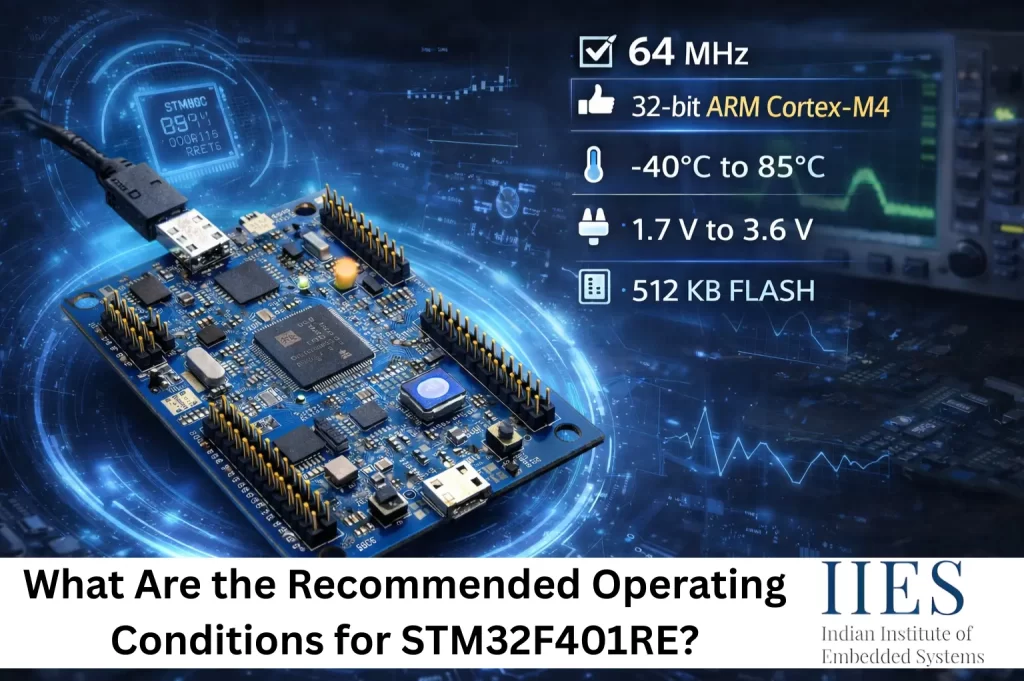One of the most fundamental operating conditions for the STM32F401RE microcontroller is the voltage supply. The device operates within a voltage range of 1.7 V to 3.6 V. Operating outside this range can result in erratic behavior, data corruption, or permanent damage.
A stable and clean power supply is essential, especially when multiple peripherals are connected using the STM32F401RE pinout. Proper power distribution and decoupling help maintain reliable operation in real-world embedded systems.

Clock Frequency and Clock Source
The STM32F401RE microcontroller relies on an internal or external clock source to synchronize internal operations. It supports clock frequencies up to 84 MHz, allowing flexibility based on performance and power requirements.
Users can select internal oscillators or external crystal sources depending on system design. When configuring the clock, it is important to consider peripheral timing requirements and overall power efficiency. Correct clock configuration ensures reliable operation of the STM32F401RE microcontroller across different applications.
Operating Temperature Range
The operating temperature range is another critical parameter for the STM32F401RE microcontroller. Depending on the variant, it supports temperature ranges of –40°C to 85°C or –40°C to 105°C.
Exceeding these limits can affect timing, reliability, and overall system stability. In applications where the STM32F401RE pinout connects to high-current peripherals or operates in harsh environments, proper thermal management becomes even more important.
ESD (Electrostatic Discharge) Protection
Electrostatic discharge poses a serious risk to electronic components, including the STM32F401RE microcontroller. Improper handling or insufficient protection can cause immediate or long-term failures.
Using ESD-safe workstations, grounding techniques, and protective packaging is strongly recommended. At the system level, adding protection components to interfaces connected through the STM32F401RE pinout improves resilience against electrostatic damage.

Current Consumption and Power Modes
Power efficiency is a key consideration in many embedded designs. The STM32F401RE microcontroller offers multiple power modes that allow designers to optimize current consumption based on operational needs.
Low-power modes can be used during idle periods to reduce energy usage, especially in battery-powered applications. Understanding current consumption behavior under different operating conditions helps designers maximize efficiency without compromising performance.
Input and Output (I/O) Characteristics
Understanding the input and output characteristics of the STM32F401RE microcontroller is essential when interfacing with external components. The STM32F401RE pinout provides a variety of digital and analog I/O pins, each with specific voltage and current limitations.
Signals applied to these pins must remain within the specified limits to prevent damage. Proper pin configuration, pull-up or pull-down settings, and voltage compatibility ensure reliable communication with external peripherals.
Memory Considerations
The STM32F401RE microcontroller includes on-chip Flash memory for program storage and SRAM for data handling. Developers should ensure memory usage remains within specified limits to maintain stable operation.
When external memory devices are connected through available interfaces in the STM32F401RE pinout, timing requirements and operating conditions must be carefully followed to ensure data integrity and system reliability.
Reset and Startup Behavior
Proper handling of reset and startup sequences is critical for predictable system initialization. Designers should follow recommended power-on and power-off procedures when working with the STM32F401RE microcontroller.
Correct reset configuration helps avoid unexpected behavior during power cycling or system resets, particularly in industrial and safety-critical applications.






